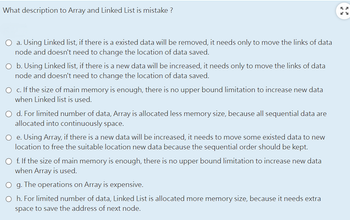
Concept explainers

c. If the size of main memory is enough, there is no upper bound limitation to increase new data when Linked list is used.
This is not true. While linked lists do not have a size limit like arrays, they can only grow as long as there is enough memory available to store the new data. If there is not enough memory available, then the linked list will not be able to grow.
e. Using Array, if there is a new data will be increased, it needs to move some existed data to new location to free the suitable location new data because the sequential order should be kept.
This is not necessarily true. While it may be the case that some data needs to be moved in order to make room for new data in an array, this is not always the case. It depends on the implementation of the array.
f. If the size of main memory is enough, there is no upper bound limitation to increase new data when Array is used.
This is not true. While arrays do not have a size limit like linked lists, they can only grow as long as there is enough memory available to store the new data. If there is not enough memory available, then the array will not
g. The operations on Array is expensive. This is not necessarily true. The expense of operations on an array depends on the implementation of the array.
Step by stepSolved in 2 steps

thank you!
but what is the answer?
thank you!
but what is the answer?
- What to do? 1. Create at least 10 data (data.txt): you can use names, product, or number type data. 2. Create a Java program to read the data file. 3. While your program is running, let the user do the following: push, pop, top operations. 4. Use either bounded model (array) or unbounded model (linked list): up to your preference. 5. Your program must show the proper message to the user so that user can choose what operation does. 6. After each operation, your program shows the result. 7. Your program runs until the user quits the program by selecting a menu. Program input A single .txt file named "data.txt". Program output Your program output must be a reasonable way of display. What to turn in? 1. Pseudocode file (must include all class files including application with main method) 2. Source code and data.txt filearrow_forwardWhy is designed a Doubly linked list with Head Node usually ? (multiple choice) a. System analyzer requested it. b. Yes. It is naturally circular style. c. All of the link fields are used in data nodes. O d. A specialized data needs to save in Head Node. e. All of programmers use it in USA.arrow_forwardDevelop a procedure that will allow you to remove from a linked list all of the nodes that share a key?arrow_forward
- Which of the following statement or statements are true ? Please check all that apply. Both the linkedlist and array size needs to be pre-decided Arrays have better cache locality that can make them better in terms of performance. It's easier to insert and delete elements from array than from the linkedlist Data type of the linked list doesnot need to be same, whereas in array, it must be the same memory can be allocated at runtime both for linkedlist and dynamic array Which of the following statements are true? Check all that applies 5 points Accessing any element of an array has the time complexity of O(n) Searching for an element in array and linkedlist has the same time complexity Inserting or Deleting an element from a stack or queue has the same time complexity Accessing an element from a singly…arrow_forward12 - final question An element can be inserted at or removed from the beginning, middle, or end of a linked list. Assuming we have a pointer to the head of linked list only. Which of the three locations is the most computationally expensive to add/remove? a. Beginning of linked list b. Middle of linked list c. End of linked listarrow_forwardTrue or False For each statement below, indicate whether you think it is True or False. If you like, you can provide a description of your answer for partial credit in case you are incorrect. Use the standard linked list below to answer True/False statements 9-12: 8 7 null 4 10 The “head” pointer of this list is pointing to Node 4 If we called “insert(5)”, the new node’s “next” pointer will point to Node 8 If we called “delete(10)”, Node 7’s “next” pointer will point to Node 8 If we called “search(20)”, the “head” pointer will be at Node 4 after the search function endsarrow_forward
 Database System ConceptsComputer ScienceISBN:9780078022159Author:Abraham Silberschatz Professor, Henry F. Korth, S. SudarshanPublisher:McGraw-Hill Education
Database System ConceptsComputer ScienceISBN:9780078022159Author:Abraham Silberschatz Professor, Henry F. Korth, S. SudarshanPublisher:McGraw-Hill Education Starting Out with Python (4th Edition)Computer ScienceISBN:9780134444321Author:Tony GaddisPublisher:PEARSON
Starting Out with Python (4th Edition)Computer ScienceISBN:9780134444321Author:Tony GaddisPublisher:PEARSON Digital Fundamentals (11th Edition)Computer ScienceISBN:9780132737968Author:Thomas L. FloydPublisher:PEARSON
Digital Fundamentals (11th Edition)Computer ScienceISBN:9780132737968Author:Thomas L. FloydPublisher:PEARSON C How to Program (8th Edition)Computer ScienceISBN:9780133976892Author:Paul J. Deitel, Harvey DeitelPublisher:PEARSON
C How to Program (8th Edition)Computer ScienceISBN:9780133976892Author:Paul J. Deitel, Harvey DeitelPublisher:PEARSON Database Systems: Design, Implementation, & Manag...Computer ScienceISBN:9781337627900Author:Carlos Coronel, Steven MorrisPublisher:Cengage Learning
Database Systems: Design, Implementation, & Manag...Computer ScienceISBN:9781337627900Author:Carlos Coronel, Steven MorrisPublisher:Cengage Learning Programmable Logic ControllersComputer ScienceISBN:9780073373843Author:Frank D. PetruzellaPublisher:McGraw-Hill Education
Programmable Logic ControllersComputer ScienceISBN:9780073373843Author:Frank D. PetruzellaPublisher:McGraw-Hill Education





